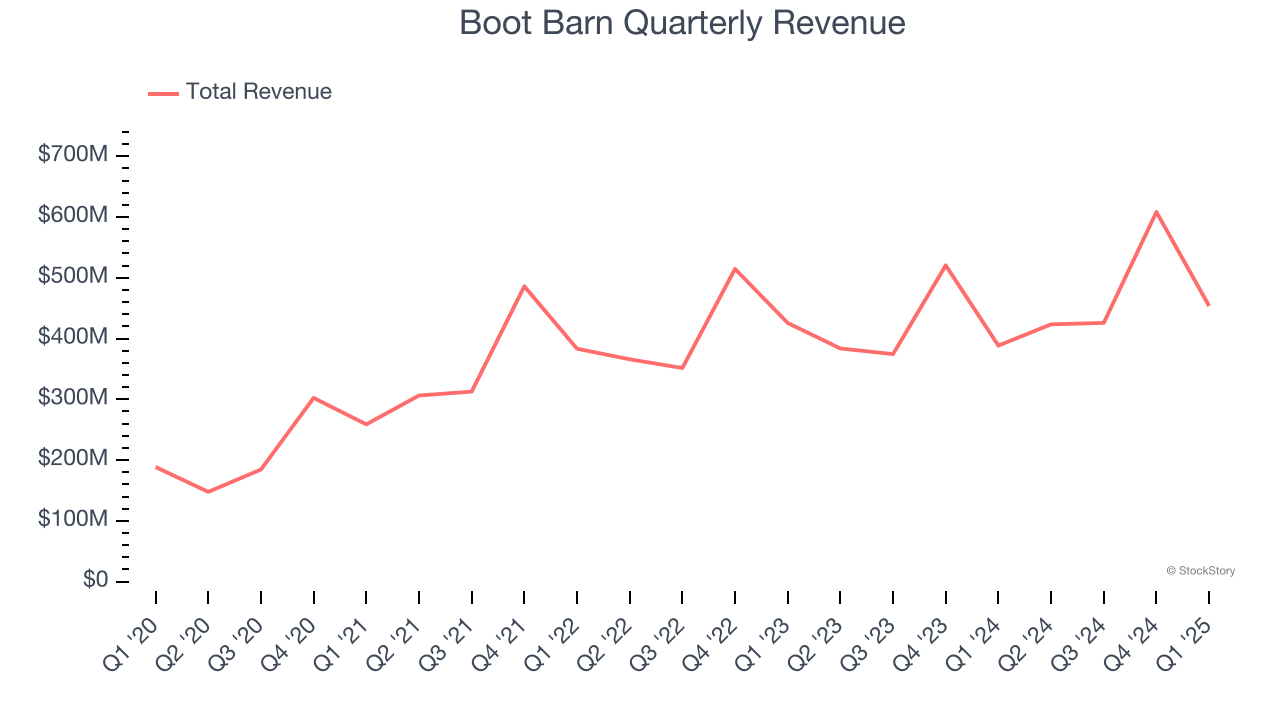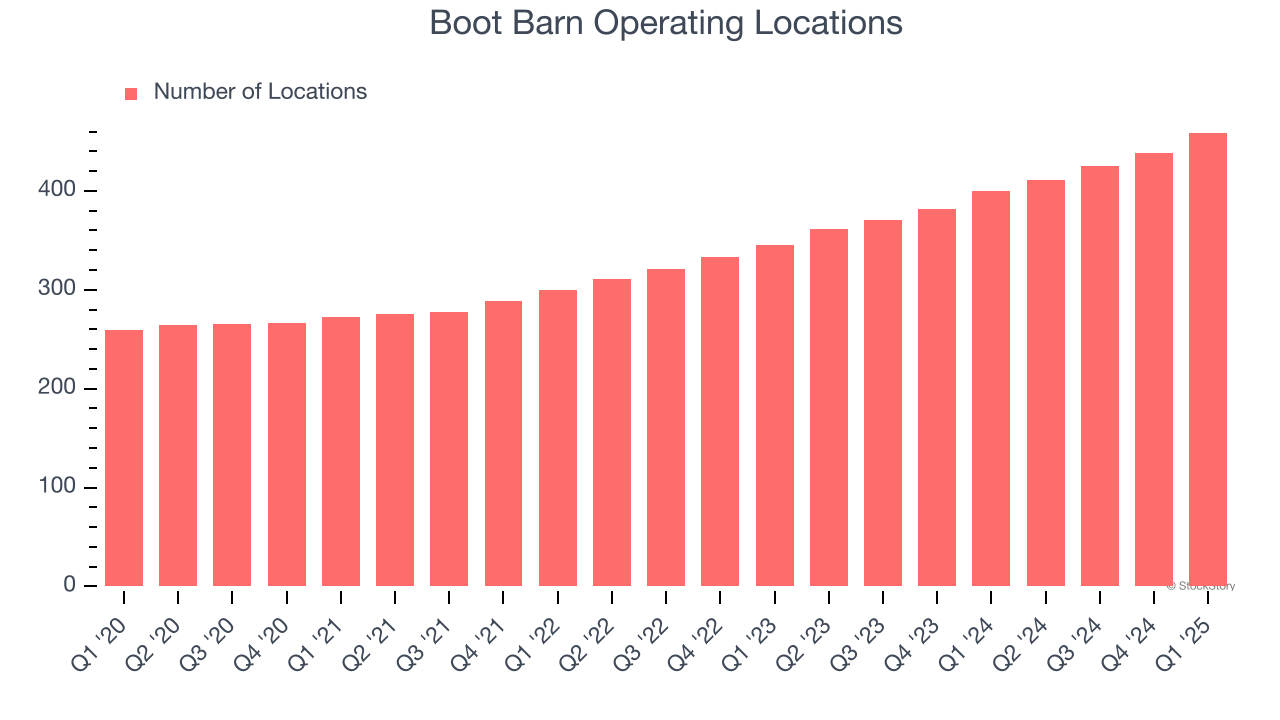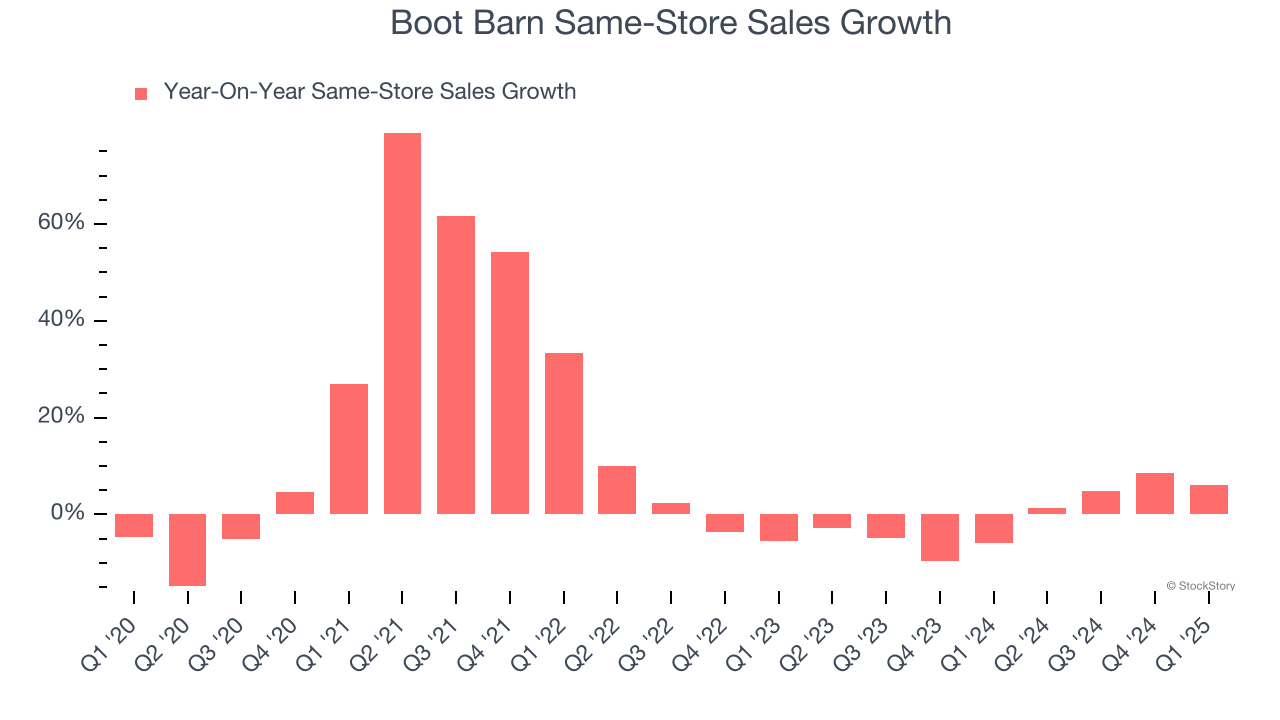
Clothing and footwear retailer Boot Barn (NYSE:BOOT) missed Wall Street’s revenue expectations in Q1 CY2025, but sales rose 16.8% year on year to $453.7 million. On the other hand, the company expects next quarter’s revenue to be around $487 million, close to analysts’ estimates. Its GAAP profit of $1.22 per share was 1.6% below analysts’ consensus estimates.
Is now the time to buy Boot Barn? Find out by accessing our full research report, it’s free.
Boot Barn (BOOT) Q1 CY2025 Highlights:
- Revenue: $453.7 million vs analyst estimates of $458 million (16.8% year-on-year growth, 0.9% miss)
- EPS (GAAP): $1.22 vs analyst expectations of $1.24 (1.6% miss)
- Adjusted EBITDA: $112.1 million vs analyst estimates of $68.58 million (24.7% margin, 63.5% beat)
- Management’s revenue guidance for the upcoming financial year 2026 is $2.11 billion at the midpoint, missing analyst estimates by 2.8% and implying 10.4% growth (vs 14.4% in FY2025)
- EPS (GAAP) guidance for the upcoming financial year 2026 is $5.95 at the midpoint, missing analyst estimates by 4.3%
- Operating Margin: 11%, up from 9.8% in the same quarter last year
- Free Cash Flow was -$753,000 compared to -$31.86 million in the same quarter last year
- Locations: 459 at quarter end, up from 400 in the same quarter last year
- Same-Store Sales rose 6% year on year (-5.9% in the same quarter last year)
- Market Capitalization: $4.13 billion
John Hazen, Chief Executive Officer, commented, “Our team delivered a solid finish to fiscal year 2025 highlighted by 15% annual total sales growth and 23% growth in earnings per diluted share, underscoring the ongoing resilience of our core consumer despite broader market uncertainties. The continued strength across major merchandise categories, channels, and geographies reaffirms the broad appeal of our brand and the effectiveness of our strategic initiatives. As we look ahead, we remain confident in our ability to navigate the current tariff environment through our diversified sourcing capabilities and established vendor partnerships. The fundamentals of our business remain strong, and we are well-positioned to continue generating value for our shareholders.”
Company Overview
With a strong store presence in Texas, California, Florida, and Oklahoma, Boot Barn (NYSE:BOOT) is a western-inspired apparel and footwear retailer.
Sales Growth
Examining a company’s long-term performance can provide clues about its quality. Any business can experience short-term success, but top-performing ones enjoy sustained growth for years.
With $1.91 billion in revenue over the past 12 months, Boot Barn is a small retailer, which sometimes brings disadvantages compared to larger competitors benefiting from economies of scale and negotiating leverage with suppliers. On the bright side, it can grow faster because it has more white space to build new stores.
As you can see below, Boot Barn grew its sales at an impressive 16.2% compounded annual growth rate over the last six years (we compare to 2019 to normalize for COVID-19 impacts) as it opened new stores and expanded its reach.

This quarter, Boot Barn’s revenue grew by 16.8% year on year to $453.7 million but fell short of Wall Street’s estimates. Company management is currently guiding for a 15% year-on-year increase in sales next quarter.
Looking further ahead, sell-side analysts expect revenue to grow 13.9% over the next 12 months, a slight deceleration versus the last six years. Still, this projection is noteworthy and indicates the market is forecasting success for its products.
Software is eating the world and there is virtually no industry left that has been untouched by it. That drives increasing demand for tools helping software developers do their jobs, whether it be monitoring critical cloud infrastructure, integrating audio and video functionality, or ensuring smooth content streaming. Click here to access a free report on our 3 favorite stocks to play this generational megatrend.
Store Performance
Number of Stores
The number of stores a retailer operates is a critical driver of how quickly company-level sales can grow.
Boot Barn operated 459 locations in the latest quarter. It has opened new stores at a rapid clip over the last two years, averaging 15% annual growth, much faster than the broader consumer retail sector. This gives it a chance to scale into a mid-sized business over time.
When a retailer opens new stores, it usually means it’s investing for growth because demand is greater than supply, especially in areas where consumers may not have a store within reasonable driving distance.

Same-Store Sales
A company's store base only paints one part of the picture. When demand is high, it makes sense to open more. But when demand is low, it’s prudent to close some locations and use the money in other ways. Same-store sales gives us insight into this topic because it measures organic growth for a retailer's e-commerce platform and brick-and-mortar shops that have existed for at least a year.
Boot Barn’s demand within its existing locations has barely increased over the last two years as its same-store sales were flat. Boot Barn should consider improving its foot traffic and efficiency before expanding its store base.

In the latest quarter, Boot Barn’s same-store sales rose 6% year on year. This growth was a well-appreciated turnaround from its historical levels, showing the business is regaining momentum.
Key Takeaways from Boot Barn’s Q1 Results
We were impressed by how significantly Boot Barn blew past analysts’ EBITDA expectations this quarter. On the other hand, its revenue and EPS fell short along with its full-year guidance for both metrics. Overall, this was a weaker quarter, but the stock traded up 11.2% to $148 immediately following the results due to the EBITDA beat.
Should you buy the stock or not? When making that decision, it’s important to consider its valuation, business qualities, as well as what has happened in the latest quarter. We cover that in our actionable full research report which you can read here, it’s free.
